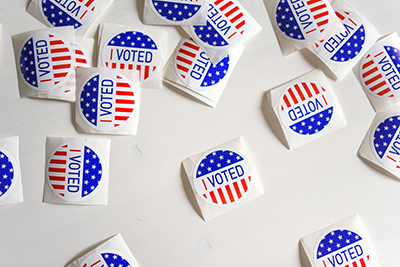New IPR Research: February 2022
Get all our news

This month’s new research from IPR faculty explores the prevalence of adverse childhood experience of students in Chicago Public Schools, the connection between parents' education and the stress of their high school-aged children during the COVID-19 pandemic, and how narratives shape migration policies. This research also examines to what extent Americans are willing to sell their votes, applying partial identification to public health, and attitudes toward intimate partner violence in sub-Saharan Africa.
Social Disparities and Health
The Prevalence of Adverse Childhood Experience in Chicago Public Schools
Adverse childhood experiences (ACEs) have been shown to have a negative effect on long-term health. In the Journal of School Health, community health researcher and IPR associate Joe Feinglass and his colleagues study the prevalence of two specific ACEs among Chicago public high school students together with self-reported health-risk behaviors. The researchers analyzed 1,883 Chicago Public School (CPS) students’ responses to the 2017 Youth Risk Behavior Survey (YRBS), a national survey evaluating high school students’ experiences. The CPS survey included two ACEs questions about whether the student had ever experienced physical abuse by an adult and whether adults in their home had ever physically hurt each other. The researchers then correlated student scores from the YRBS for violence and victimization, substance use, sexual health risk, mental health, housing insecurity, and physical health with the ACE responses. Overall, 28% of participants reported that they experienced one ACE or both; 17.8% reported experiencing physical abuse and 19.8% reported witnessing domestic violence. The results show that ACEs are a common experience among CPS high school students with an average of 8 students in a classroom of 30 reporting having experienced an ACE. Given the well-known associations between ACEs, adolescent risk behaviors, and adult mental and physical health, the researchers call for greater awareness by school personnel and the creation of trauma informed support systems that can help mitigate child adversity.
Parents’ Education and Adolescents’ Stress During the COVID-19 Pandemic
 After the COVID-19 pandemic disrupted daily life for Americans, many were concerned about how these changes would affect children. In the Journal of Adolescent Health, IPR graduate research assistant Sarah Collier Villaume, IPR developmental psychologist Emma Adam, and their colleagues study changes in adolescents’ perceived stress and mood at the beginning of the pandemic. The researchers recruited 128 Midwestern high school students from an ongoing, longitudinal study. The students were enrolled at two suburban high schools—one public and one private—and over half were a racial-ethnic minority. The students completed questionnaires about their daily stress and mood before the pandemic between December 2017–March 2020 and at the beginning of the pandemic between March–July 2020. They also ranked their parents’ education level. The researchers discovered that adolescents living in low to moderate education households reported an increase in family and health-related stress that was four times as high as adolescents in high education households. Adolescents in low and moderately educated households also reported feeling more ashamed, caring, and excited than before the pandemic, with adolescents from high education households reporting decreases in anger and excitement. They conclude the burden imposed by COVID-19 was not equal across households, with adolescents from lower-educated households experiencing more stress and negative moods than their peers from higher-educated households, possibly because of concerns about family finances or health risk. The researchers propose that school-based health centers and mental health facilities can play a role in supporting students struggling emotionally during the pandemic. Adam is Edwina S. Tarry Professor of Human Development and Social Policy.
After the COVID-19 pandemic disrupted daily life for Americans, many were concerned about how these changes would affect children. In the Journal of Adolescent Health, IPR graduate research assistant Sarah Collier Villaume, IPR developmental psychologist Emma Adam, and their colleagues study changes in adolescents’ perceived stress and mood at the beginning of the pandemic. The researchers recruited 128 Midwestern high school students from an ongoing, longitudinal study. The students were enrolled at two suburban high schools—one public and one private—and over half were a racial-ethnic minority. The students completed questionnaires about their daily stress and mood before the pandemic between December 2017–March 2020 and at the beginning of the pandemic between March–July 2020. They also ranked their parents’ education level. The researchers discovered that adolescents living in low to moderate education households reported an increase in family and health-related stress that was four times as high as adolescents in high education households. Adolescents in low and moderately educated households also reported feeling more ashamed, caring, and excited than before the pandemic, with adolescents from high education households reporting decreases in anger and excitement. They conclude the burden imposed by COVID-19 was not equal across households, with adolescents from lower-educated households experiencing more stress and negative moods than their peers from higher-educated households, possibly because of concerns about family finances or health risk. The researchers propose that school-based health centers and mental health facilities can play a role in supporting students struggling emotionally during the pandemic. Adam is Edwina S. Tarry Professor of Human Development and Social Policy.
Politics, Institutions, and Public Policy
How Narratives Shape Migrant Policies
In 2015, Lisbeth Zornig Andersen, former chair of Denmark’s Children’s Council, was unaware she broke the law when she helped Syrian refugees who entered Danish territory by giving them a ride in her car. She was charged with moving irregular migrants or people smuggling. In Third World Quarterly, political scientist and IPR associate Galya Ben-Arieh and Volker Heins examine why helping migrants, as Andersen did, has become criminalized and how narrative practices can alter the meaning of the law. Specifically, they look at how two viewpoints they call “narratives of legality” have added moral significance and emotional meaning to migrant policy and global migration management. First, Ben-Arieh and Heins look at the role of “smuggler narratives,” which are perceptions that villainize migrant smugglers and represent pro-migrant citizens and non-government organizations (NGOs) as accomplices to migrant smugglers. The researchers show how migrant smuggling narratives have moved away from legal settings and have become popularized among far-right groups in Europe and the United States. This narrative, they argue, has facilitated policies by wealthy countries that limit migration from the South. The other narrative they examine is the “rescue narrative,” which portrays migrants as victims of cruel countries and Western governments as collaborators to repressive countries in the South. They argue the downside of this narrative is that it depicts all migrants from the South as victims and depicts Western civilians, like Andersen, as “rescuers.” They conclude both narratives are powerful tools of persuasion that influence attitudes about migrants and migration policy.
Would You Sell Your Vote?
Many in the U.S. are concerned about the state of democracy in the U.S. with increased political polarization,
extremist candidates, and weakened civil liberties. In American Politics Research, political scientist and IPR associate Jordan Gans-Morse and his co-author investigate to what extent are Americans willing to sell their votes. In a nationally representative survey of 1,000 individuals conducted between Nov. 5–6, 2016, they asked  respondents if they would accept money from a congressional candidate for their vote. They find 12% of respondents would sell their vote for $25, nearly 20% would sell it for $100, and almost one third of respondents would accept an offer of less than $1,000. Before the Nov. 2018 elections, they conducted a similar survey asking 1,206 individuals whether they would sell their vote and how important it was to live in a democracy. Respondents who placed more value on democracy were the least willing to sell their vote and over twice as likely to refuse the vote-buying offers compared to those who ranked democracy lower. In both surveys, the results show that those with higher earnings and a strong partisan leaning were less likely to say they would sell their vote. The evidence indicates that despite the U.S.’s role as a long-standing democracy, a substantial number of Americans indicate they would sell their vote for a small amount of money. The researchers suggest that researchers and policymakers should take note of this high number when considering democratic skepticism in the U.S., and they argue that further research and data are needed to understand Americans’ attitudes about selling their vote.
respondents if they would accept money from a congressional candidate for their vote. They find 12% of respondents would sell their vote for $25, nearly 20% would sell it for $100, and almost one third of respondents would accept an offer of less than $1,000. Before the Nov. 2018 elections, they conducted a similar survey asking 1,206 individuals whether they would sell their vote and how important it was to live in a democracy. Respondents who placed more value on democracy were the least willing to sell their vote and over twice as likely to refuse the vote-buying offers compared to those who ranked democracy lower. In both surveys, the results show that those with higher earnings and a strong partisan leaning were less likely to say they would sell their vote. The evidence indicates that despite the U.S.’s role as a long-standing democracy, a substantial number of Americans indicate they would sell their vote for a small amount of money. The researchers suggest that researchers and policymakers should take note of this high number when considering democratic skepticism in the U.S., and they argue that further research and data are needed to understand Americans’ attitudes about selling their vote.
Quantitative Methods for Policy Research
Applying Partial Identification to Public Health
Most preventive medicine and public health researchers report exact values when assessing risks of illness or predicting treatment response. However, researchers must deal with missing data and may make unjustifiable assumptions about these gaps, leading to misleading conclusions. IPR economist Charles F. Manski and his colleagues recommend in the American Journal of Preventative Medicine that researchers use partial discovery, or partial identification, to determine more informative results, and they apply it to three real-world scenarios. Partial identification strategies provide a range of values and make more realistic assumptions about missing data. The first example looks at child vaccination data, which can be missing for several reasons, such as parents refusing to share information. Here, a partial identification approach helps identify the lowest possible vaccination rate and the highest. The second examines a trial investigating treatment for hypertension. Here only a small amount of outcome data are missing, which means researchers do not need to make assumptions about the missing data. A partial identification strategy determines a narrow range of options to help clinicians propose treatments to different patients. In the last example, they assess COVID-19 infection rates, which can be inaccurate due to missing data from untested people who are asymptomatic carriers of the virus, as well as tests that are not entirely accurate. A partial identification strategy gives more practical information about COVID-19 infection rates and underscores the need for better data and testing strategies. The researchers conclude that partial identification can address public health and preventative medicine issues, including the ongoing COVID-19 pandemic, estimating how common and severe infections are, and making decisions on potential vaccines and treatments based on preliminary clinical trials. Manski is Board of Trustees Professor in Economics.
Child, Adolescent & Family Studies
Attitudes Toward Intimate Partner Violence in Sub-Saharan Africa
 In sub-Saharan Africa, reports of intimate partner violence (IPV) are among the highest in the world, with roughly one in three women saying they have experienced IPV in their lives. In Demography, IPR sociologist Julia Behrman and her colleague examine whether similarities or differences in a couple's characteristics are associated with couples’ joint attitudes toward IPV. The researchers examine a subset of survey data of couples from 33 countries in sub-Saharan countries. The survey, collected between 2008 and 2018, asked husbands and wives about scenarios in which wife beating was acceptable and whether wives experienced IPV in the last 12 months, along with other questions about age, education, media consumption, and whether they were employed. They find that when looking at individuals, 50% of women and 70% of men reject all IPV scenarios, but when they look at couples, 61% said in at least one response that it was justified for a husband to beat his wife. The findings also show that similar exposure to education, work, and media consumption is more predictive that a couple will both reject IPV than if only one had been exposed to them. The researchers suggest this could be because joint exposure to messaging condemning IPV is mutually reinforcing, women may have more bargaining power with more education and a job, or individuals may select a partner with similar perspectives. The results suggest that interventions should target couples to shift attitudes about IPV, rather than men or women separately.
In sub-Saharan Africa, reports of intimate partner violence (IPV) are among the highest in the world, with roughly one in three women saying they have experienced IPV in their lives. In Demography, IPR sociologist Julia Behrman and her colleague examine whether similarities or differences in a couple's characteristics are associated with couples’ joint attitudes toward IPV. The researchers examine a subset of survey data of couples from 33 countries in sub-Saharan countries. The survey, collected between 2008 and 2018, asked husbands and wives about scenarios in which wife beating was acceptable and whether wives experienced IPV in the last 12 months, along with other questions about age, education, media consumption, and whether they were employed. They find that when looking at individuals, 50% of women and 70% of men reject all IPV scenarios, but when they look at couples, 61% said in at least one response that it was justified for a husband to beat his wife. The findings also show that similar exposure to education, work, and media consumption is more predictive that a couple will both reject IPV than if only one had been exposed to them. The researchers suggest this could be because joint exposure to messaging condemning IPV is mutually reinforcing, women may have more bargaining power with more education and a job, or individuals may select a partner with similar perspectives. The results suggest that interventions should target couples to shift attitudes about IPV, rather than men or women separately.
Photo credits: Unsplash
Published: February 18, 2022.


